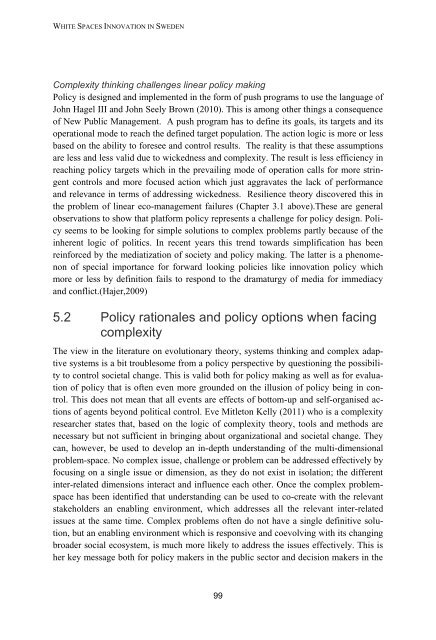White Spaces Innovation in Sweden - Innovation policy for ... - Vinnova
White Spaces Innovation in Sweden - Innovation policy for ... - Vinnova
White Spaces Innovation in Sweden - Innovation policy for ... - Vinnova
Create successful ePaper yourself
Turn your PDF publications into a flip-book with our unique Google optimized e-Paper software.
WHITE SPACES INNOVATION IN SWEDENComplexity th<strong>in</strong>k<strong>in</strong>g challenges l<strong>in</strong>ear <strong>policy</strong> mak<strong>in</strong>gPolicy is designed and implemented <strong>in</strong> the <strong>for</strong>m of push programs to use the language ofJohn Hagel III and John Seely Brown (2010). This is among other th<strong>in</strong>gs a consequenceof New Public Management. A push program has to def<strong>in</strong>e its goals, its targets and itsoperational mode to reach the def<strong>in</strong>ed target population. The action logic is more or lessbased on the ability to <strong>for</strong>esee and control results. The reality is that these assumptionsare less and less valid due to wickedness and complexity. The result is less efficiency <strong>in</strong>reach<strong>in</strong>g <strong>policy</strong> targets which <strong>in</strong> the prevail<strong>in</strong>g mode of operation calls <strong>for</strong> more str<strong>in</strong>gentcontrols and more focused action which just aggravates the lack of per<strong>for</strong>manceand relevance <strong>in</strong> terms of address<strong>in</strong>g wickedness. Resilience theory discovered this <strong>in</strong>the problem of l<strong>in</strong>ear eco-management failures (Chapter 3.1 above).These are generalobservations to show that plat<strong>for</strong>m <strong>policy</strong> represents a challenge <strong>for</strong> <strong>policy</strong> design. Policyseems to be look<strong>in</strong>g <strong>for</strong> simple solutions to complex problems partly because of the<strong>in</strong>herent logic of politics. In recent years this trend towards simplification has beenre<strong>in</strong><strong>for</strong>ced by the mediatization of society and <strong>policy</strong> mak<strong>in</strong>g. The latter is a phenomenonof special importance <strong>for</strong> <strong>for</strong>ward look<strong>in</strong>g policies like <strong>in</strong>novation <strong>policy</strong> whichmore or less by def<strong>in</strong>ition fails to respond to the dramaturgy of media <strong>for</strong> immediacyand conflict.(Hajer,2009)5.2 Policy rationales and <strong>policy</strong> options when fac<strong>in</strong>gcomplexityThe view <strong>in</strong> the literature on evolutionary theory, systems th<strong>in</strong>k<strong>in</strong>g and complex adaptivesystems is a bit troublesome from a <strong>policy</strong> perspective by question<strong>in</strong>g the possibilityto control societal change. This is valid both <strong>for</strong> <strong>policy</strong> mak<strong>in</strong>g as well as <strong>for</strong> evaluationof <strong>policy</strong> that is often even more grounded on the illusion of <strong>policy</strong> be<strong>in</strong>g <strong>in</strong> control.This does not mean that all events are effects of bottom-up and self-organised actionsof agents beyond political control. Eve Mitleton Kelly (2011) who is a complexityresearcher states that, based on the logic of complexity theory, tools and methods arenecessary but not sufficient <strong>in</strong> br<strong>in</strong>g<strong>in</strong>g about organizational and societal change. Theycan, however, be used to develop an <strong>in</strong>-depth understand<strong>in</strong>g of the multi-dimensionalproblem-space. No complex issue, challenge or problem can be addressed effectively byfocus<strong>in</strong>g on a s<strong>in</strong>gle issue or dimension, as they do not exist <strong>in</strong> isolation; the different<strong>in</strong>ter-related dimensions <strong>in</strong>teract and <strong>in</strong>fluence each other. Once the complex problemspacehas been identified that understand<strong>in</strong>g can be used to co-create with the relevantstakeholders an enabl<strong>in</strong>g environment, which addresses all the relevant <strong>in</strong>ter-relatedissues at the same time. Complex problems often do not have a s<strong>in</strong>gle def<strong>in</strong>itive solution,but an enabl<strong>in</strong>g environment which is responsive and coevolv<strong>in</strong>g with its chang<strong>in</strong>gbroader social ecosystem, is much more likely to address the issues effectively. This isher key message both <strong>for</strong> <strong>policy</strong> makers <strong>in</strong> the public sector and decision makers <strong>in</strong> the99
















